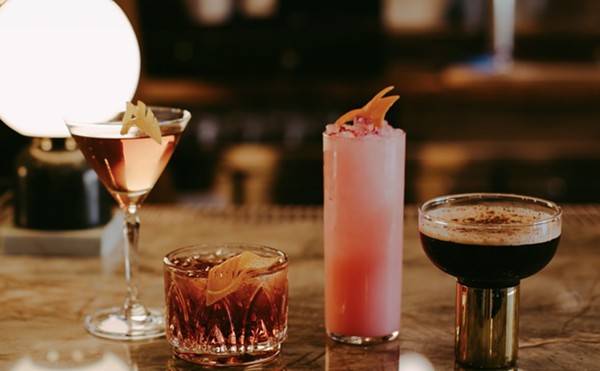You know that extra virgin olive oil you bought at the supermarket? You might as well toss it, because it’s probably no good.
Yeah, I was a little surprised, and saddened too, but apparently much of the commercial olive oil on the market isn’t up to snuff. If it seems greasy, get rid of it. And if it starts to have too much of a bite, it’s no good. Olive oil has a shelf life of no more than 18 months, and a lot of what you buy commercially technically is rancid, according to Bob Hundley, who owns Primo Oils & Vinegars at 3628 Brownsboro Road with his wife, Beverly Bromley.
I visited with Hundley recently, and did a quick tasting of a couple of oils that were well within their shelf limits, and he pointed out just how intense and flavorful an olive oil can be. For instance, he offered me a taste of a Spanish oil, called Melgarejo Hojiblanca EVOO, and it was like nothing I’d ever experienced. Loaded with polyphenols — which apparently is quite healthful — it had a nutty, fresh flavor.
Yes, it was nothing like that market-brand oil I’ve been using. Not even close.
I also got a taste of a Portuguese oil labeled as Corbrancosa, and it had an even more striking flavor, like fresh green herbs.
“It’s a freshness thing,” Hundley said, talking about how to know a good oil from a bad oil. One key is knowing when the olives are crushed into oil, which, of course, refers to the shelf life. Flavor is another factor.
“If you can sample it, you can make an educated guess, if nothing else,” he said. Of course, in a supermarket, sampling directly from the bottles is, er, frowned upon. You get what you pay for, in other words. (He said that olive oil is such a big industry, even organized crime is sometimes involved.)
And, so, to stock his shelves, Hundley goes for the latest and greatest, based on harvest (and always makes sure it is crime-free). He said that currently what’s in Primo Oils is all from the Northern Hemisphere. Sometime around the end of summer, the stock will shift to products from the Southern Hemisphere.
Of course, there are also plenty of oils that are flavored with things such as garlic, rosemary and even chipotle peppers. Those are more of an American thing.
“In Italy, they’re going to laugh at you and throw rocks at you,” if you use flavored oils, Hundley said. Duly noted — no flavored olive oil when in Italy due to risk of shaming and potential bodily harm.
A product that goes hand in hand with olive oil at stores, including Primo, is vinegar — balsamic vinegar in particular. I also stopped in at Zi Olive in Westport Village, and a friendly employee there was all too happy to let me sample several of the vinegars available for purchase.
OK, when I think of balsamic vinegars, I think of the stuff you put on your salad with a bit of feta cheese. Based on what I’ve had, it’s a mild and unique taste that doesn’t stray much from a particular flavor profile, except for occasionally when a restaurant will offer a strawberry vinaigrette. Well, it turns out that balsamics come in more forms than I thought.
Often, they are aged like wines, some of them for 25 years. Or like bourbons. Which is my segue into mentioning something I never would have thought existed: Kentucky bourbon barrel vinaigrette. Yes, that’s right, there is a balsamic vinegar that is aged in bourbon barrels, and it’s amazing. And intense. And it’s also healthful — or at least it carries fewer calories than, say, ranch dressing.
There are plenty of others as well, from fruits to maple syrup to chocolate. And if you’re wondering what to do with vinegars like that, well, Zi offers ideas. For instance, let some fresh berries soak in the chocolate vinegar for a while, and you’ve got a healthful and delicious treat. And the bourbon vinegar makes a great marinade for steak or brisket.
Of course, all of this brings me to one question. What on Earth am I going to do with that big bottle of off-brand olive oil in my cabinet?







